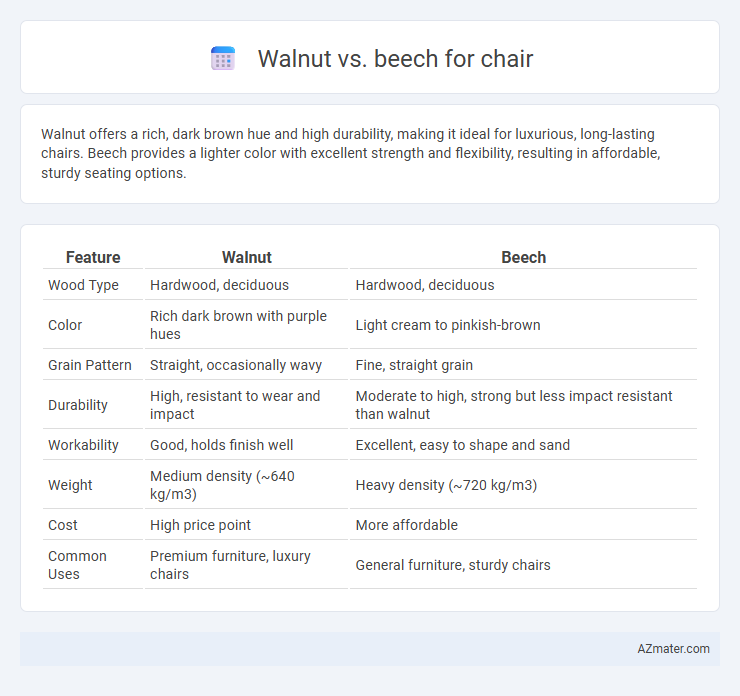Walnut offers a rich, dark brown hue and high durability, making it ideal for luxurious, long-lasting chairs. Beech provides a lighter color with excellent strength and flexibility, resulting in affordable, sturdy seating options.
Table of Comparison
| Feature | Walnut | Beech |
|---|---|---|
| Wood Type | Hardwood, deciduous | Hardwood, deciduous |
| Color | Rich dark brown with purple hues | Light cream to pinkish-brown |
| Grain Pattern | Straight, occasionally wavy | Fine, straight grain |
| Durability | High, resistant to wear and impact | Moderate to high, strong but less impact resistant than walnut |
| Workability | Good, holds finish well | Excellent, easy to shape and sand |
| Weight | Medium density (~640 kg/m3) | Heavy density (~720 kg/m3) |
| Cost | High price point | More affordable |
| Common Uses | Premium furniture, luxury chairs | General furniture, sturdy chairs |
Introduction: Walnut vs Beech for Chair Making
Walnut and beech are popular hardwoods commonly used in chair making due to their durability and aesthetic appeal. Walnut features rich, dark tones with intricate grain patterns, offering a luxurious and elegant finish ideal for high-end furniture. Beech, on the other hand, provides a lighter, uniform appearance with excellent strength and shock resistance, making it a practical choice for both modern and traditional chair designs.
Wood Characteristics: Walnut and Beech
Walnut wood features a rich, dark brown color with a fine, straight grain that offers excellent durability and natural resistance to wear, making it ideal for high-quality chairs. Beech wood is lighter in tone, typically pale cream with a tight, uniform grain, known for its hard, strong, and shock-resistant properties, providing sturdy support for chair construction. Both woods are prized for their smooth finish and ability to accept stains well, but walnut's distinctive color and grain add a touch of luxury compared to the more utilitarian appeal of beech.
Appearance and Grain Patterns
Walnut chairs showcase rich, deep brown tones with a smooth, straight grain often accented by unique, swirling patterns that highlight the wood's natural character. Beech features a lighter, cream-colored appearance with a fine, consistent grain pattern that provides a clean, uniform look ideal for modern or minimalist chair designs. The choice between walnut and beech for chair construction depends on the desired aesthetic, with walnut offering warmth and complexity, while beech delivers brightness and simplicity.
Strength and Durability Comparison
Walnut wood features a moderate density of around 640 kg/m3, offering good strength and a natural resistance to wear, making it suitable for high-end, durable chairs. Beech wood has a higher density, approximately 720 kg/m3, which provides superior hardness and excellent shock resistance, enhancing its durability for everyday chair use. Both woods offer sturdy performance, but Beech's greater hardness makes it more resistant to dents and impact over time compared to Walnut.
Workability and Ease of Shaping
Walnut offers excellent workability with its fine, straight grain and moderate density, making it easy to shape and carve for detailed chair designs. Beech, known for its uniform texture and hardness, provides reliable machining and sanding performance, allowing precise shaping without tearing or splintering. Both woods respond well to hand and machine tools, but walnut's slightly softer nature grants smoother finishes and finer detailing in chair craftsmanship.
Comfort and Ergonomics for Chairs
Walnut wood offers a smooth, dense grain that contributes to sturdy and supportive chair frames, enhancing ergonomic stability and long-term comfort. Beech wood's fine, tight grain provides exceptional flexibility and resilience, allowing chairs to adapt subtly to body movements for improved comfort and posture support. Both woods are favored in chair design, but walnut's firmness suits robust ergonomic requirements, while beech excels where lightweight flexibility enhances seating comfort.
Finishing Options and Aesthetics
Walnut offers rich, dark hues with natural grain patterns that enhance chair aesthetics through smooth, oil-based finishes that highlight its warmth and depth. Beech features a lighter, more uniform color that pairs well with various stains and clear lacquers, providing a versatile base for modern or traditional chair designs. Both woods accommodate finishes that protect durability while accentuating their unique textures, but walnut's natural elegance often commands a premium look in upscale furniture.
Cost and Availability of Walnut vs Beech
Walnut chairs typically cost more due to the wood's rich grain, durability, and slower growth, making it a premium hardwood in furniture manufacturing. Beech is more readily available and affordable, sourced from fast-growing, widely distributed trees, which lowers its market price and ensures steady supply. For budget-conscious buyers, beech offers a cost-effective alternative without compromising basic strength and workability compared to walnut.
Sustainability and Environmental Impact
Walnut and beech differ significantly in sustainability and environmental impact for chair production. Beech wood is often sourced from fast-growing, sustainably managed forests with lower carbon footprints compared to walnut, which grows more slowly and is generally harvested less frequently, leading to a higher environmental impact. Choosing beech for chair manufacturing supports regenerative forestry practices and reduces ecological strain, making it a more eco-friendly option.
Best Applications: Choosing the Right Wood for Your Chair
Walnut offers rich color and natural durability, making it ideal for high-end, decorative chairs that require strength and aesthetic appeal. Beech is a lighter, more affordable hardwood favored for minimalist or modern chairs due to its consistent grain and excellent workability. Selecting walnut enhances visual warmth and longevity, while beech suits functional, everyday seating with smooth finishes and stability.

Infographic: Walnut vs Beech for Chair
 azmater.com
azmater.com